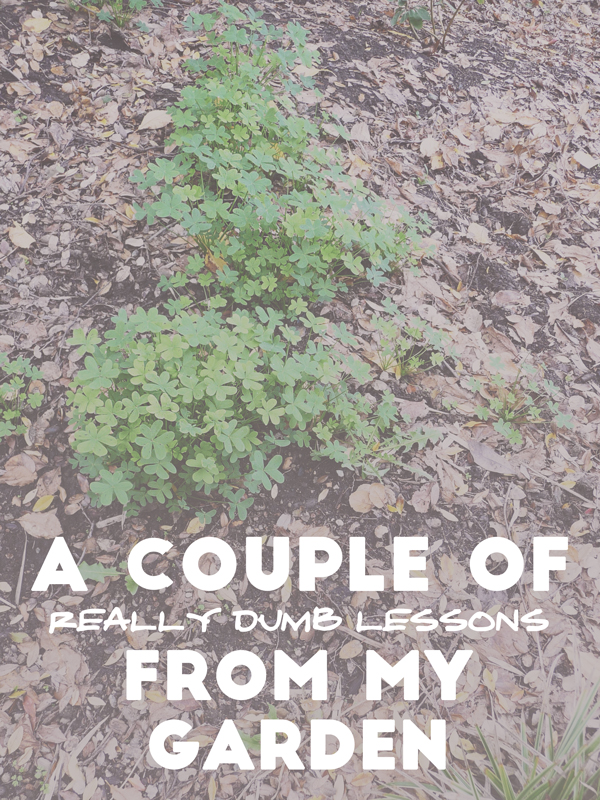
Gardens are such obvious teachers we might wave our hands in dismissal. “Oh,” with an additional shake of the head, “We knew that already!” But in these days of information and calculation, dumb lessons dog us.
Imagine a California garden in winter, for example. Palm trees, surfers and tropical flowers may come to mind. Nope. We’re north. Home to fallen leaves, red berries, and decaying camellias. That particular camellia is a sasanqua, if you wondered.
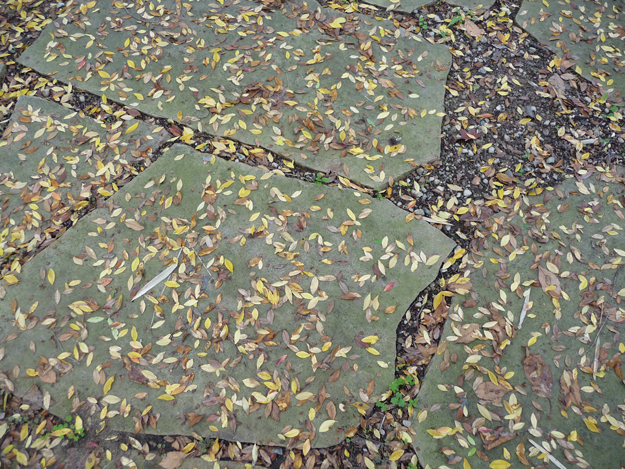
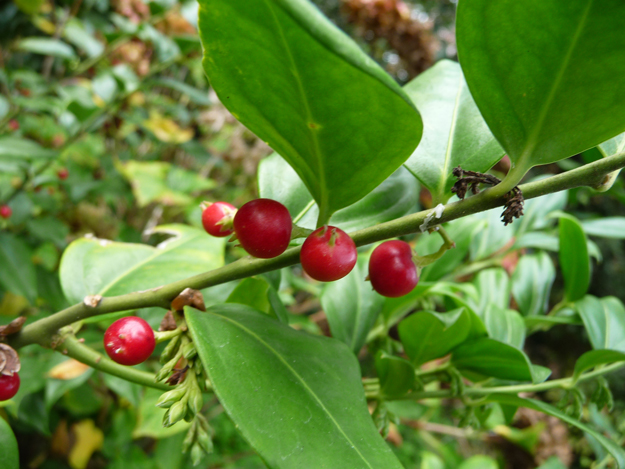
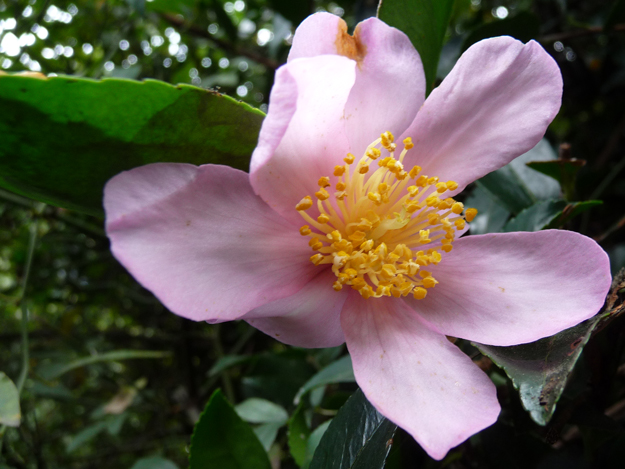
My part of California doesn’t go white in December. We’ll get gray skies with rain, or blue with still-warm sun. Both support growth.
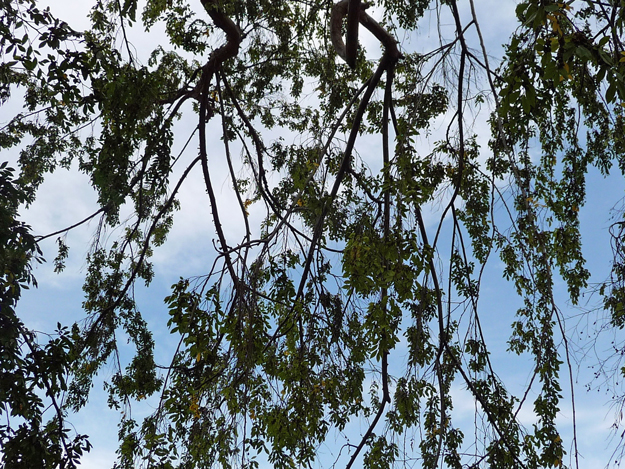
So little new green things sprout just as our leaves fall. These below look like 4-leaf clovers, but they are actually oxalis. An acid yellow flower will follow, but disappear almost as quickly as it blooms. As I imagine prairie winds act on grasses, but would have to visit to know.
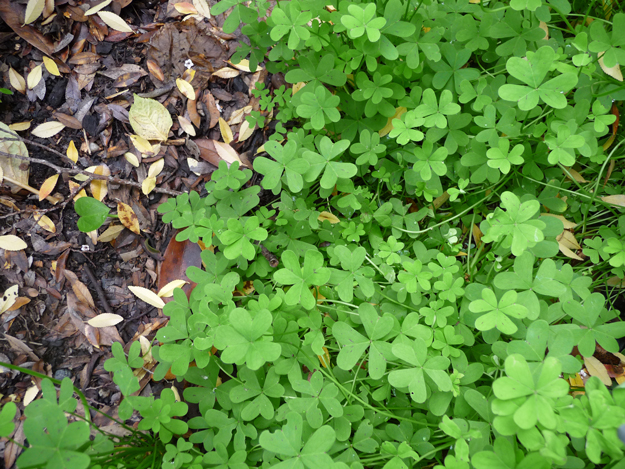
Here’s a bush called “mock orange.” When bruised, the shrubby foliage smells like a car crash of orange peel and gasoline, so hold your breath to prune.
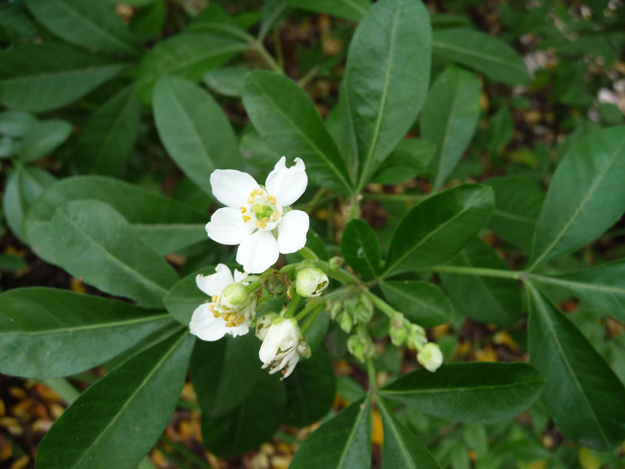
And a teeny pink flower, whose species I don’t know. Barely the size of my little fingernail, pretending to be a carnation, and I for one will not wreck its dreams. I like to think my garden’s accidental and all the plants nameless.
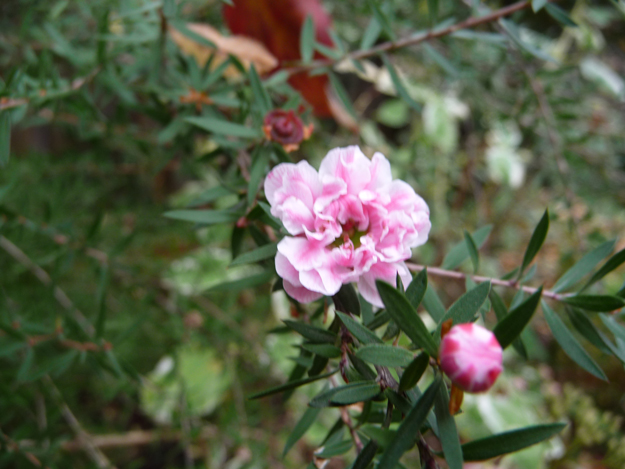
While Conceptual California is vivid, large and maybe laughing, the earth version is subtle in its seasons, and minute in its blooms.
Pay attention. Unvalidated concepts can be risky.
We might also imagine, “A paradise! How wonderful to live in such growth!” And while for me that’s true, think of what we miss, back up a bit. I never experience the drama of a New England winter, as documented beautifully by Jeanne on Collage of Life. Her berries, vivid on a bare branch.
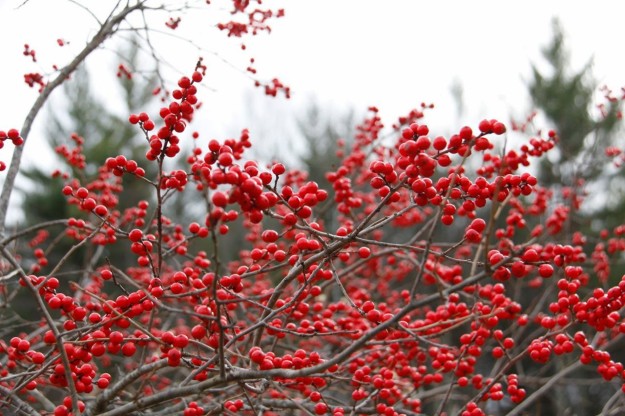
Coastal Californians can’t grow tulips, unless we refrigerate the bulbs. Kind of destroys the romance, right? “‘Scuse me while I rummage ’round the mustard jars and find my flowers-to-be.”
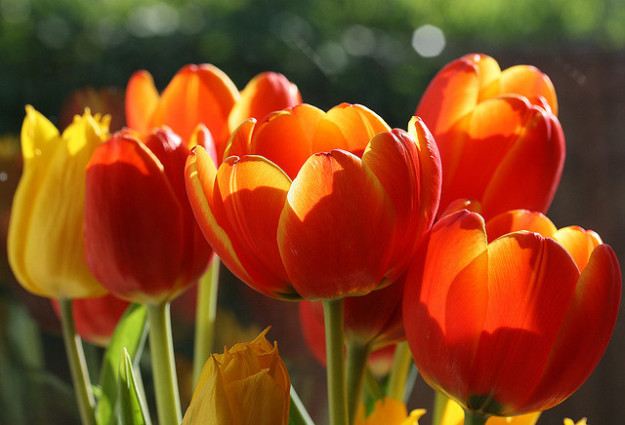
Can’t grow overflowing lilacs.

Or peonies, glamorous in their youth. Even more so in decay.
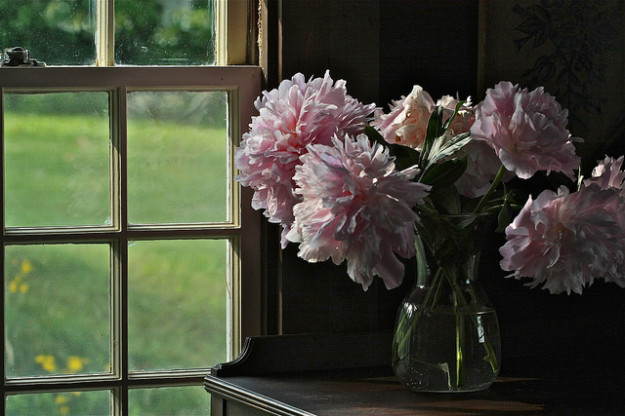
Big flowers need winter rest. Nobody could keep up Full Peony without a little time off. They call it “vernalization.”
Now, back up so far in conceptual space that you can see Australia. Imagine we’re horticultural astronauts. In Australia Christmas means a day at the beach, and Faux Fuchsia, the doyenne of Vivid, Authentic, and Committed, protecting her garden from bush turkeys. Behold, as pink as her nails, green as Puccis.
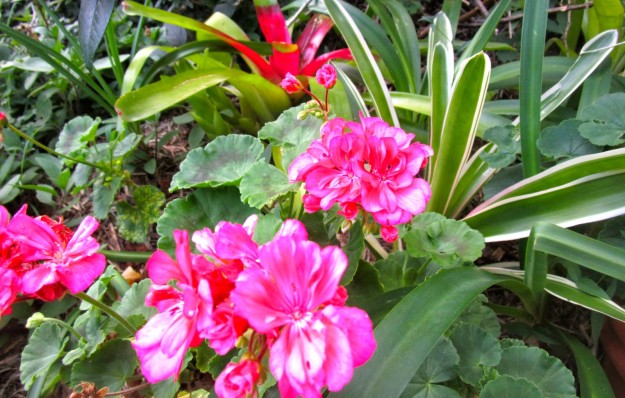
Another dumb lesson. Lives are different. The world supports us all.
Sometimes the dumb lessons are the hardest to learn, even for smart people in the smartest of all possible worlds. We’re embedded in our surroundings. It’s as close as I get to rapture, looking closely, then flying backwards to see the wide horizon.
A dumb hope.
Peace on earth, the real earth, and good will towards all that live.
*
Photo credits:
Tulips on my Windowsill by Jill Clardy
Lilacs by Ann Althouse
The Last Of The Peonies by Smilla4
Winterberries by Jeanne at Collage of Life
Australian Winter Garden by FF at Faux Fuchsia
All others, me
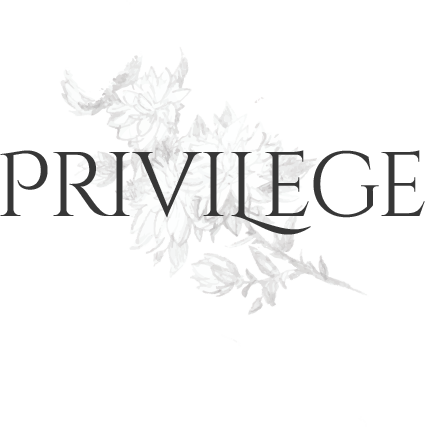
29 Responses
Such wisdom and spoken so eloquently….
Thank you again Lisa, your blog thoughts and words are pure poetry.
Thank you.
Beautiful. Just beautiful. “Lives are different. The world supports us all”. I need to internalize that. XX
Thank you. I work on internalizing it too.
What a lovely post. Our camellias are just beginning to bloom, spring comes early this year.
Thank you. I think the sasanquas bloom in the winter – and are unique in that.
Everything here is grey and blah, so your garden’s cheerful colors really perked things up for me! Thank you!
My pleasure!
As much as I love California, this post reminded me of how I do miss the dramatic seasons of the Northeast. However, I’m a native Californian, my family lives here, and I am forever grateful to be back. The “big blooms” come in other forms. Beautiful post.
@kathy, Thank you. Interesting, yes, the big blooms do come in other forms. xox.
Our coastal home is a horticultural paradise!
“Found on five continents, the mediterranean biome includes the Mediterranean Basin, the western United States (California) and Mexico (northwest Baja), central Chile, the cape region of South Africa, and south and southwestern Australia.
These five areas cover just 2% of the Earth’s land area, but support 20% of the Earth’s known vascular plant diversity. …
http://startortoises.net/map-climatezones.html
I consider it more than a fair exchange to give up all those fragrant flowers (that so desperately need a winter chill) for the ability to grow almost 20% of the world’s plant varieties.
Looks like your tiny pink “carnation” is a form of leptospermum, an Australian native hailing from that continent’s coastal mediterranean zone.
@rosekraft, I think the tiny ‘carnation’ looks a lot like the New Zealand native Manuka (also called Ti-tree)http://www.terrain.net.nz/friends-of-te-henui-group/leptospermum-scoparium-cultivars.html
And hooray for gardens and the outdoors and gentle lessons.
@rosekraft, I had no idea. How fun to know! And yes, now that you say the name, since in fact it was planted and I was told what it was called, Leptotspermum. Thank you.
Nothing blooming here except for the red cardinal I saw last week on the leafless branch outside my window. A brilliant spot of red amidst all the brown. And now, after our big storm, all the white. Still, I feel better for having read this post. We can definitely do big blooms up here…if winter snow and cold is required!
@Sue B @highheelsinthewilderness.blogspot.ca, I’ve never lived as far north as you – and I imagine it feels all kinds of ways I can’t even imagine.
Hi Lisa this is my first post. I read your post and thought ahh if only you knew how hard it was to have a Christmas garden in Australia (before I reached the part on faux fushia’s garden) which vacillates from flooding rain (not that often) to prolonged drought. This means water restrictions are often in place. Here in Sydney the jacarandas have just finished and the Australian Christmas bush will blush for a short time before the frangipanis bloom. Other English flowering plants will flower until a summer scorcher (38 degrees Celsius or more) hits. I live in a clay belt so have roses but all else is green through hours of judicious watering and fertilising. Looking forward to a warm possibly hot Christmas Day. Yvonne
@Yvonne, Welcome! I can imagine the unpredictable and intense conditions are tough. But it leads to poetry,”Here in Sydney the jacarandas have just finished and the Australian Christmas bush will blush for a short time before the frangipanis bloom.” Merry possibly hot Christmas to you!
ah yes. A garden writer (no longer with us, alas) used to call certain practices “zonal denial.”
I’ve lived in such diverse climates–Miami, North Carolina, Chicago, San Francisco, Laguna Beach, and now Oregon. It makes the head spin. And in my time, I’ve loved them all……….
@Jean S, You really have lived the spectrum. Is there any place that has really felt most like home, physically?
Buds of wisdom in this post.
The only things blooming here are indoors. Hellebores now, amaryllis for Christmas Eve if we timed them right.
@Linda Pakravan, Buds:). And good luck with the amaryllis!
Having grown up in New England, lived in Hawaii and now in Virginia, I have come to appreciate the diversity of each locale. This week we are experiencing mostly grey skies, but even this I have learned to appreciate – just don’t want it to last too long!
I think that’s what exploration gives you – wider appreciation, right?
Thank you so much for including my bromeliads and geraniums and baby’s tears! I have had to fight tooth and nail since August against Old Testament Weather Conditions to get this garden looking ok. It still looks scrappy, but things are alive and some are flowering and that’s enough for me. I love the authentic and committed comments and think about them all the time.
xxxxxx
You’re the real deal. <3
You live in a pretty nice part of the world – where some lovely flowers bloom :-).
Agreed:).
I grew up in the Bay Area, and we had a lilac in the back yard. If you wanted one, you could probably find a variety that would work where you live. In a quick search I found this article:
http://homeguides.sfgate.com/lilac-trees-can-grown-zone-9-29796.html
“The dumb lessons are the hardest to learn”….I hear you on that one Lisa. Too many to count for me last summer but I am ready to start again. Loved seeing my photo in your collection…so many beautiful plants to consider. I am now the wiser on Northern California gardens, I would love to visit one day.
Sending you warm wishes from Saigion for a Happy New Year!! ;)